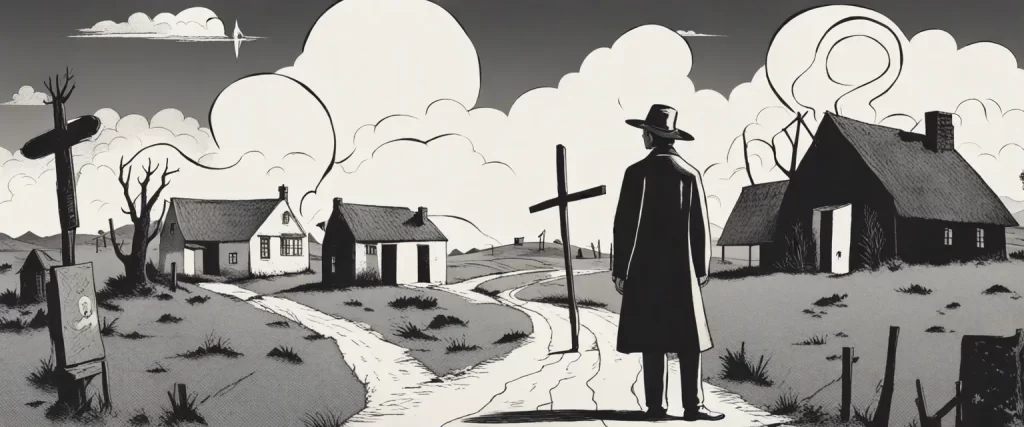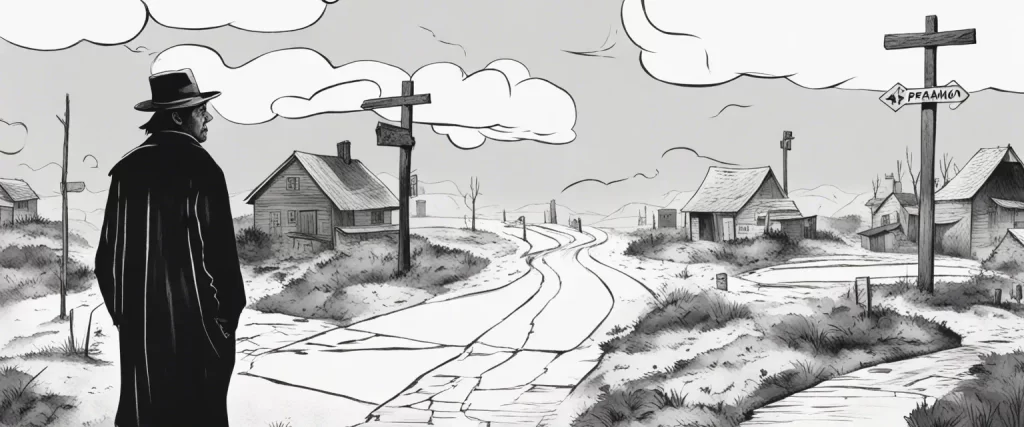——The Life of Lazarillo de Tormes by Anonymous & Pedro Paramo by Juan Rulfo
Literature has always been a mirror reflecting the diverse aspects of human life, transcending time and boundaries. Oftentimes, through the exploration of various narratives, authors examine the human condition and shed light on societal issues that have persisted throughout history. In this comparative study, we will delve into two engaging and profound works: “The Life of Lazarillo de Tormes” by Anonymous and “Pedro Paramo” by Juan Rulfo. Although originating from different time periods and cultural contexts, these texts share common themes and techniques, offering valuable insights into the human experience.
The Life of Lazarillo de Tormes” is an anonymous Spanish novel published in 1554 during the height of the Spanish Inquisition. It is considered one of the first and most influential picaresque novels, narrating the life of a clever and resourceful young boy named Lazarillo as he navigates the harsh realities of 16th-century Spanish society. Set against a backdrop of poverty, hunger, and deceit, Lazarillo’s story exposes the hypocritical social structures and provides a critique of the prevailing moral and ethical norms of that time.
On the other hand, “Pedro Paramo,” written by Mexican author Juan Rulfo and published in 1955, is a novel that transcends traditional narrative conventions. It presents a nonlinear and fragmented structure, blurring the boundaries between reality and the supernatural. Through the fragmented memories and voices of various characters, Rulfo captures the desolate atmosphere of a ghost town named Comala and explores themes of isolation, death, and the eternal search for identity.
While “The Life of Lazarillo de Tormes” focuses on the individual’s struggle for survival within a hierarchical society, “Pedro Paramo” delves into the haunting consequences of repression and the persisting traumas inflicted upon individuals and communities in the aftermath of the Mexican Revolution. Despite the differences in historical context and narrative structure, a comparative analysis of these two works can uncover fascinating similarities, highlighting how both authors employ their respective storytelling techniques to challenge dominant social paradigms and expose the underlying injustices prevalent in their societies.
Throughout this study, we will examine these two literary masterpieces side by side, analyzing their thematic concerns, narrative strategies, and the impact of socio-political contexts on their creation. By juxtaposing “The Life of Lazarillo de Tormes” and “Pedro Paramo,” we hope to offer a deeper understanding of the social issues explored in these works, as well as illuminate the timeless nature of the human struggle for freedom, meaning, and self-discovery in the face of adversity.
Brief Summary of Two Books
The Life of Lazarillo de Tormes by Anonymous
“The Life of Lazarillo de Tormes” is a Spanish picaresque novel written anonymously during the 16th century. The story follows the life and adventures of Lázaro de Tormes, a young boy who grows up in poverty and becomes a witty and cunning servant.
Lázaro’s journey begins when he is taken in as a servant by a blind beggar, who turns out to be a dishonest and manipulative individual. Lázaro learns to fend for himself, using his intelligence and resourcefulness to survive in a society filled with corruption and deceit.
Throughout the novel, Lázaro serves various masters, each of whom teaches him valuable lessons about the harsh realities of life. From a greedy priest who uses Lázaro for his own benefits to a cruel squire who mistreats him, Lázaro witnesses the flaws and moral decay of those in power.
However, Lázaro himself is not innocent, as he learns to deceive and manipulate others in order to improve his own circumstances. He adapts to survive in a world where morality is often compromised, thus making him a true picaro, a clever rogue.
“The Life of Lazarillo de Tormes” serves as a satirical critique of Spanish society and its social structure during the Renaissance period. It sheds light on the corruption, hypocrisy, and inequality prevalent at the time, while also highlighting the resilience and ingenuity of the common people.
Overall, the novel provides a vivid portrayal of the challenges faced by individuals in a society overcome by poverty, greed, and moral decay, solidifying its place as a significant masterpiece in Spanish literature.
Pedro Paramo by Juan Rulfo
Pedro Páramo is a novel written by Mexican author Juan Rulfo. It was first published in 1955 and is considered one of the most important works in Latin American literature. The narrative is set in Comala, a fictional town in Mexico.
The novel follows the story of Juan Preciado, a young man who travels to Comala in search of his father, Pedro Páramo, after his mother’s death. However, upon arriving in the town, Juan discovers a desolate and ghostly place, haunted by the memories and presence of its deceased inhabitants. He encounters the spirit of his dead mother, as well as numerous other spirits who recount their experiences and memories of when they were alive.
The narrative is told through a series of fragmented and nonlinear perspectives, shifting between different characters and time periods. It explores themes of death, memory, guilt, and the search for identity. As Juan delves deeper into the dark past of Comala, he uncovers the secrets and sins that have plagued the town for generations, particularly those of his father, Pedro Páramo.
Pedro Páramo is known for its poetic and dreamlike prose, blending reality and fantasy in a way that blurs the boundaries between the living and the dead. It explores the complex layers of Mexican history and society, as well as the impact of oppressive systems and entrenched power structures on individuals and communities.
Overall, Pedro Páramo is a haunting and powerful novel that offers a profound exploration of love, loss, and the human condition, while also illuminating the social and historical context of rural Mexico. It is regarded as a modern classic and a masterpiece of Mexican literature.
Comparison between Two Books

Similarities in Fiction Classics
The Life of Lazarillo de Tormes and Pedro Paramo are both highly regarded works of fiction that can be considered classics in their respective genres. Although they were written in different time periods and settings, there are several similarities that can be identified in these books.
1. Unconventional protagonists: Both novels feature unconventional and morally ambiguous protagonists. In The Life of Lazarillo de Tormes, Lazarillo is a young boy who navigates his way through a series of masters, showcasing his cunning and survival skills. In Pedro Paramo, the titular character is a wealthy landowner who is portrayed as ruthless and manipulative. Both characters challenge the traditional idea of a heroic or virtuous protagonist.
2. Social critique: Both novels reflect a strong social critique of their respective societies. The Life of Lazarillo de Tormes satirizes the hypocrisies and corruption of the Spanish society, showcasing the struggles of the lower classes. Pedro Paramo critiques the oppressive nature of feudalism and the power dynamics within Mexican society. Both books shed a critical light on the social injustices of their time.
3. Experimental narrative techniques: Both novels employ unconventional narrative techniques that contribute to their unique storytelling styles. The Life of Lazarillo de Tormes is written in a picaresque style, which is a series of episodic anecdotes. This fragmented narrative mirrors Lazarillo’s fragmented life and adds a sense of realism. Pedro Paramo, on the other hand, uses a nonlinear structure, blending different perspectives and flashbacks, creating a dreamlike and haunting atmosphere.
4. Themes of death and disillusionment: Both books explore themes of death and disillusionment. In The Life of Lazarillo de Tormes, death is a recurring motif throughout the story, symbolizing the harsh realities of life. Lazarillo’s experiences with death serve as a reminder of the transience and brutality of human existence. Pedro Paramo delves into the theme of disillusionment, reflecting the existential crisis of its characters and their search for meaning in a desolate and empty world.
5. Symbolic landscapes: The settings in both novels serve as symbolic landscapes that contribute to the overall themes and atmosphere. The Life of Lazarillo de Tormes is set in various towns and cities, including Salamanca and Toledo, representing the different social strata and the contrasting facets of Spanish society. Pedro Paramo takes place in the ghost town of Comala, which serves as a metaphor for the spiritual decay and corruption of the land.
In conclusion, both The Life of Lazarillo de Tormes and Pedro Paramo share several similarities as fictional classics. They both feature unconventional protagonists, provide social critiques, employ experimental narrative techniques, explore themes of death and disillusionment, and employ symbolic landscapes. These similarities contribute to their enduring status as revered works of literature.
Divergences in Fiction Classics
The Life of Lazarillo de Tormes and Pedro Paramo are two significant works of fiction that belong to the genre of Fiction Classics. Both books offer valuable insights into the cultural, social, and psychological aspects of their respective time periods. However, they diverge in several aspects.
1. Narrative Structure:
– The Life of Lazarillo de Tormes is an episodic novel composed of seven novellas that offer a sequential account of Lazarillo’s life as he serves different masters. It follows a picaresque structure that emphasizes the protagonist’s humorous adventures and social criticism.
– Pedro Paramo, on the other hand, presents a nonlinear narrative structure. It weaves together multiple storylines from different characters, blurring the boundaries between reality, memory, and the afterlife. The story is told through fragmented and subjective perspectives, creating a complex and mysterious atmosphere.
2. Protagonist’s Journey:
– In The Life of Lazarillo de Tormes, Lazarillo embarks on a journey of survival in a cruel and unforgiving world. He faces constant abuse, poverty, and deprivation and learns to manipulate and deceive people to secure his own well-being.
– Pedro Paramo follows Juan Preciado, who travels to Comala to search for his father, Pedro Paramo. The journey becomes a descent into the world of the dead, as Juan encounters ghostly characters and experiences the haunting consequences of his father’s actions.
3. Social Commentary:
– The Life of Lazarillo de Tormes serves as a biting critique of the Spanish society during the Renaissance period. It exposes the corruption and hypocrisy prevalent among the upper classes and portrays the life of the lower class as harsh and full of struggle.
– Pedro Paramo, set in rural Mexico during the early 20th century, critiques the oppressive social structure and religious fanaticism that dominated the region. It reveals the consequences of land exploitation and highlights the pervasive influence of the Church.
4. Writing Styles:
– The Life of Lazarillo de Tormes is known for its witty and satirical writing style. It utilizes humor, sarcasm, and irony to criticize the vices and moral decadence of its time.
– Pedro Paramo adopts a more poetic and atmospheric style. The lyrical prose creates a haunting ambiance that mirrors the themes of death, loss, and emptiness portrayed throughout the book.
The Life of Lazarillo de Tormes and Pedro Paramo showcase the varied possibilities within the Fiction Classics genre. While both books explore socio-cultural aspects of their respective societies, they diverge in terms of narrative structure, the protagonist’s journey, social commentary, and writing styles. These divergences highlight the individuality and uniqueness of each work, contributing to their lasting impact in the literary world.

Conclusion
Both The Life of Lazarillo de Tormes and Pedro Paramo are highly regarded works in Spanish literature and have their own unique merits. Ultimately, the choice of which book is more worthy of reading may depend on individual preferences and interests.
The Life of Lazarillo de Tormes, written in the 16th century by an anonymous author, is considered the first picaresque novel. It tells the story of Lazarillo, a poor boy who serves different masters and experiences a series of adventures in his quest for survival. This novel satirically examines the social and moral corruption of Spanish society during that time. It offers a satirical critique of social hierarchies and provides a fascinating glimpse into the cultural and historical context of the period.
On the other hand, Pedro Paramo, written by Juan Rulfo in the mid-20th century, is a highly influential novel of the magical realism genre. Set in a fictional Mexican town, the story follows a man named Juan Preciado as he searches for his father, Pedro Paramo. Through a nonlinear narrative and multiple perspectives, the novel explores themes of memory, identity, and death. Rulfo’s writing style is known for its poetic language and evocative storytelling, making Pedro Paramo a captivating and thought-provoking read.
Ultimately, both books have their own unique qualities and offer different experiences to readers. If you are interested in a satirical critique of society and an exploration of historical context, The Life of Lazarillo de Tormes may be a great choice. On the other hand, if you enjoy magical realism, poetic language, and a philosophical exploration of themes, Pedro Paramo could be more appealing.



